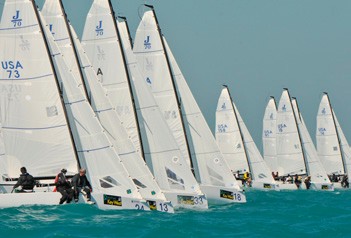From a series of email racing tips from J World, The Performance Sailing School
 When is it better to play the shifts versus going for stronger wind? To answer questions like these, it’s helpful to know how much you’ll gain in a shift. If you can quantify your decisions, they are often easier to make.
When is it better to play the shifts versus going for stronger wind? To answer questions like these, it’s helpful to know how much you’ll gain in a shift. If you can quantify your decisions, they are often easier to make.
Whether the breeze is light or heavy, there are big gains to be made by tacking or jibing on wind shifts. © Allen Clark/PhotoBoat.com
Here are some rules of thumb regarding distance gained/lost in a wind shift:
If your boat’s tacking (or gybing) angle is 90 degrees, then you’ll gain 12% of the distance between boats in a 5-degree shift, 25% in a 10-degree shift, 37% in a 15-degree shift, and 48% in a 20-degree shift. For example, if you get a 15-degree shift and you’re 1/4 mile (1,320 feet) away from a competitor, then you’ll gain or lose 488 feet. If you’re sailing in a J/80, this equates to about 19 boatlengths. That’s a lot!
If the tacking angle is larger, then the percentage gain/loss is also larger. Keep this in mind in light air, when angles are greater. A big component of the final figure is the separation between boats. This separation is often called “leverage.” Leverage can be good or bad, depending on which way the shift goes. Tacticians should always run the “what if” numbers ahead of time. This is especially helpful when considering hitting one side of a leg due to an expected geographic shift caused by land.
If you’re not the “numbers” type, consider this rule of thumb: In a shifting breeze, consider tacking when the compass shows you below your median heading AND when you can cross more boats than you’ll have to duck. Avoid the temptation to wait until you get enough of a shift to cross the majority of boats. Stay in phase, stay in a clear lane of air, and don’t be greedy!
For information on any of J World’s racing, cruising or learn-to-sail courses in Newport, RI, San Diego CA, San Francisco, CA, Annapolis, MD or Key West FL, contact them at 800-343-2255 or visit jworldschool.com.




